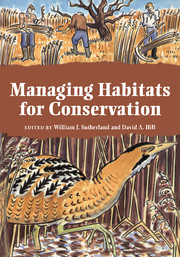Book contents
- Frontmatter
- Contents
- List of Contributors
- Acknowledgements
- 1 Introduction and principles of ecological management
- 2 Site management planning
- 3 Access
- 4 Coastal habitats
- 5 Rivers, canals and dykes
- 6 Waterbodies
- 7 Reedbeds, fens and acid bogs
- 8 Grasslands
- 9 Farmland
- 10 Lowland heathland
- 11 Upland moors and heaths
- 12 Woodland and scrub
- 13 Urban areas
- Some useful addresses
- Index of species by common names
- Subject index
12 - Woodland and scrub
Published online by Cambridge University Press: 05 February 2015
- Frontmatter
- Contents
- List of Contributors
- Acknowledgements
- 1 Introduction and principles of ecological management
- 2 Site management planning
- 3 Access
- 4 Coastal habitats
- 5 Rivers, canals and dykes
- 6 Waterbodies
- 7 Reedbeds, fens and acid bogs
- 8 Grasslands
- 9 Farmland
- 10 Lowland heathland
- 11 Upland moors and heaths
- 12 Woodland and scrub
- 13 Urban areas
- Some useful addresses
- Index of species by common names
- Subject index
Summary
Introduction
The composition and structure of the woodlands we have today have been determined as much by their history of management as by climate and soils. These factors in turn influence how we value each wood for nature conservation and the choice of management strategy and practice. Although the historical perspective has been strongly emphasised in the last 25 years, it is far from new; perhaps the first modern measure in woodland conservation was the protection of the ‘Ancient and Ornamental’ woodlands under the 1877 New Forest Act.
Ancient woods (those which have existed since before 1600) are now recognised as the most important for nature conservation (Spencer & Kirby, 1992). Many comprise modified remnants of Britain's original natural Vegetation and include communities of plants and animals which we suppose they inherited directly from the Atlantic forests and have sustained for millennia on or about their present sites. However, even secondary woodlands have a structural complexity which sets them apart from other vegetation formations and may develop into rich habitats. Whilst ancient woodlands are the priority, woodland managers should also seize every opportunity to diversify secondary woods. In a country which still has only 11% of its land area under trees, most landscapes would be enriched by establishing more woodland.
Whilst there is a good case for setting aside some woods as strictly unmanaged reserves, most woods need to be managed, both to maintain their wildlife and to yield timber and other material products. Our woodland wildlife has been heavily influenced by past management systems – notably coppice and wood-pasture – and we can most surely maintain it by continuing, or by gently adapting, the traditional systems.
- Type
- Chapter
- Information
- Managing Habitats for Conservation , pp. 327 - 361Publisher: Cambridge University PressPrint publication year: 1995
- 10
- Cited by



